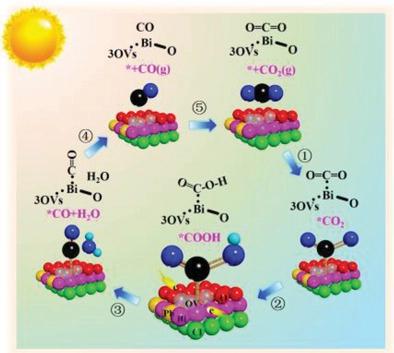当前位置:
X-MOL 学术
›
Adv. Funct. Mater.
›
论文详情
Our official English website, www.x-mol.net, welcomes your feedback! (Note: you will need to create a separate account there.)
Excited Electron-Rich Bi(3–x)+ Sites: A Quantum Well-Like Structure for Highly Promoted Selective Photocatalytic CO2 Reduction Performance
Advanced Functional Materials ( IF 19.0 ) Pub Date : 2022-06-22 , DOI: 10.1002/adfm.202202885 Bin Wang 1, 2 , Wei Zhang 1 , Gaopeng Liu 1 , Hailong Chen 3 , Yu‐Xiang Weng 3 , Huaming Li 1 , Paul K. Chu 2 , Jiexiang Xia 1
Advanced Functional Materials ( IF 19.0 ) Pub Date : 2022-06-22 , DOI: 10.1002/adfm.202202885 Bin Wang 1, 2 , Wei Zhang 1 , Gaopeng Liu 1 , Hailong Chen 3 , Yu‐Xiang Weng 3 , Huaming Li 1 , Paul K. Chu 2 , Jiexiang Xia 1
Affiliation

|
Most of the current research on the photocatalytic mechanism of semiconductors is still on the simulation and evaluation of ground-state active sites. Insights into photogenerated electron transition paths and excited-state active sites during photocatalysis are still insufficient. Herein, combining femtosecond time-resolved transient absorption spectroscopy, in situ Fourier-transform infrared spectroscopy, synchronous illumination X-ray photoelectron spectroscopy, and theoretical calculation results rationally reveal that in complex bimetallic oxyhalides the ultrathin rich oxygen vacancies (ROV) PbBiO2Cl (PBOC) double unit cell (DUC) layers facilitate migration and separation of photogenerated electrons from the bulk to Bi sites near the surface oxygen vacancies (OVs), then form the excited electron-rich Bi(3–x)+ sites like quantum well structure. The excited Bi(3–x)+ sites act as wells for photogenerated electrons leading to lower energy barrier in the rate determining step for the formation of *CO from *COOH intermediate. Without photosensitizers and sacrificial agents, ROV DUC PBOC exhibit high CO generation rate (16.02 µmol h–1 g–1) that is 18 times higher than that of bulk PBOC. In situ characterization combined with theoretical calculation provides effective insight into the photocatalytic mechanism of photoexcited semiconductor materials.
中文翻译:

激发的富电子 Bi(3–x)+ 位点:用于高度促进选择性光催化 CO2 还原性能的量子阱状结构
目前对半导体光催化机理的研究多集中在基态活性位点的模拟和评价上。对光催化过程中光生电子跃迁路径和激发态活性位点的了解仍然不足。在此,结合飞秒时间分辨瞬态吸收光谱、原位傅里叶变换红外光谱、同步照明X射线光电子能谱和理论计算结果合理地揭示了复杂双金属卤氧化物中超薄富氧空位(ROV) PbBiO 2 Cl ( PBOC) 双晶胞 (DUC) 层促进光生电子从块体迁移和分离到表面氧空位 (OVs) 附近的 Bi 位点,然后形成激发的富电子 Bi(3–x)+位点,如量子阱结构。激发的 Bi (3-x)+位点充当光生电子的阱,导致在从 *COOH 中间体形成 *CO 的速率确定步骤中能垒降低。在没有光敏剂和牺牲剂的情况下,ROV DUC PBOC 表现出高 CO 生成率 (16.02 µmol h –1 g –1 ),是散装 PBOC 的 18 倍。原位表征结合理论计算为光激发半导体材料的光催化机理提供了有效的见解。
更新日期:2022-06-22
中文翻译:

激发的富电子 Bi(3–x)+ 位点:用于高度促进选择性光催化 CO2 还原性能的量子阱状结构
目前对半导体光催化机理的研究多集中在基态活性位点的模拟和评价上。对光催化过程中光生电子跃迁路径和激发态活性位点的了解仍然不足。在此,结合飞秒时间分辨瞬态吸收光谱、原位傅里叶变换红外光谱、同步照明X射线光电子能谱和理论计算结果合理地揭示了复杂双金属卤氧化物中超薄富氧空位(ROV) PbBiO 2 Cl ( PBOC) 双晶胞 (DUC) 层促进光生电子从块体迁移和分离到表面氧空位 (OVs) 附近的 Bi 位点,然后形成激发的富电子 Bi(3–x)+位点,如量子阱结构。激发的 Bi (3-x)+位点充当光生电子的阱,导致在从 *COOH 中间体形成 *CO 的速率确定步骤中能垒降低。在没有光敏剂和牺牲剂的情况下,ROV DUC PBOC 表现出高 CO 生成率 (16.02 µmol h –1 g –1 ),是散装 PBOC 的 18 倍。原位表征结合理论计算为光激发半导体材料的光催化机理提供了有效的见解。



























 京公网安备 11010802027423号
京公网安备 11010802027423号